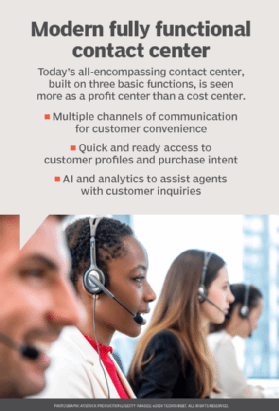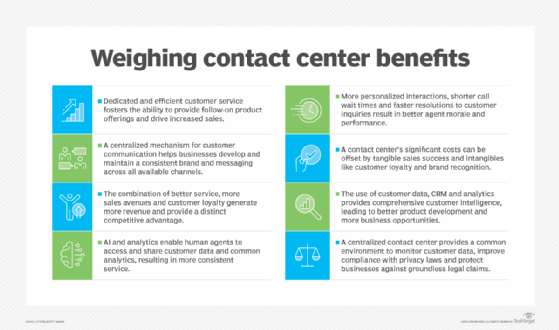8 benefits of a modern contact center
Contact centers and their multifunctional capabilities can provide businesses with a competitive edge through improved agent performance, customer engagement and brand loyalty.
Closing a sale is often the beginning of a customer relationship -- not the end. Competitive businesses must foster and support effective contact with customers to solve problems, drive customer engagement, build brand loyalty and encourage customer retention.
Modern contact centers have evolved far beyond traditional call centers, providing an array of technologies that manage customer communication across multiple mediums and analyze customer needs in ways that were impossible just a few years ago. Enterprises can take advantage of numerous modern contact center benefits.
What is a modern contact center?
In simplest terms, a contact center is the focal point of communication between a business and its customers. The core of any contact center comprises a team of knowledgeable human agents with a keen understanding of the company's products and policies. But modern contact centers use a range of additional technologies that go far beyond the traditional phone call, including the following:
- Multiple channels of communication. Most customer contact can be done without ever picking up a phone. Modern contact centers add varied means of contact such as email, chat and social media, so customers can contact a company on the channel of their choice.
- Data integration. Contact centers can record and access customer data, such as preferences, past purchases or previous issues, so agents can quickly access a customer's history and assist the customer more authoritatively without the need to repeatedly ask the same questions or gather the same information.
- Analytics and AI. The growth of analytics, machine learning and artificial intelligence enables businesses to process far more customer data, such as common questions, suggestions or complaints, that can lead to better support and product improvements.

Contact center use cases
Contact centers address several key business goals and needs, including the following:
- Generate sales. A main goal of contact centers is to make sales, such as offering new or improved products and services through deliberate lead generation (aka cold calls) or during normal customer contacts.
- Send notifications. Contact centers are valuable assets for outgoing customer communication, like notifying customers about warranty expirations, recalls or updates, or for issues where the company can improve the customer experience.
- Receive payments. Contact centers are frequently a central point for taking customer payments for products and services, such as routine monthly recurring bills, through a dedicated mobile app or web portal.
- Solve problems. Contact centers are vital for troubleshooting products and services. Support ranges from supplying product documentation and user guides to offering how-to and troubleshooting advice. Support might also come in the form of providing customers with details on returning products or additional support (escalation) using AI, chatbots, email and phone resources. Technology-based products could also possess automated capabilities for remote testing, resets and other troubleshooting alternatives.
- Improve relationships. A contact center can use analytics and AI to evaluate a customer's product and service portfolio, make expert recommendations about their current portfolio, such as reconfiguring, adding, or removing products or services, and direct company offerings with more definitive benefits for the customer and their needs or usage patterns.
Business benefits of a contact center
Contact centers promise a range of advantages and benefits for enterprises, though the specific benefits will depend heavily on business goals, needs and investment decisions. Most modern contact center benefits are focused on improved sales and a better customer experience. Within these two broad goals, enterprises can emphasize a wide variety of detailed benefits, including the following:
1. Increased sales
Contact centers are a vital platform for driving sales, typically through service, support and follow-on product offerings. A contact center, for example, can offer accessories for a key product or extend support and service agreements.
2. Stronger branding
Contact centers provide a centralized mechanism for customer communication, enabling businesses to develop and maintain a consistent brand and messaging across all available channels.
3. Competitive advantage
The combination of better service and improved sales can provide businesses with a competitive advantage, generating more revenue while building customer satisfaction, loyalty and retention.
4. Consistent service
The centralization of a contact center also brings technologies and human agents together, providing data sharing and common analytics that all human agents can access. Regardless of what human or technology platform the customer might use, the communication will be consistent and efficient.
5. Better agent performance
Ready access to customer data, such as call and purchase history, as well as timely analytics can help agents find better customer solutions through sales and support. The result is more personalized interactions, shorter wait times and improved rates of sales and support success by contact center staff.
6. Cost savings
A comprehensive contact center can create significant costs, which are often offset by tangible sales success and more intangible benefits like customer loyalty. Contact centers typically monitor a range of metrics and KPIs to track costs and performance. Such monitoring provides observability into the contact center's operational efficiency and an objective basis for optimizations and further cost savings.
7. More business opportunities
The use of customer data, CRM and analytics provides enterprises with comprehensive customer intelligence. Business leaders can use analytics and reporting to gain a better understanding of customer expectations, preferences and behaviors that can be used to drive corporate strategies and decision-making.
8. Improved compliance
Customer data typically qualifies as personally identifiable information (PII) and requires high levels of protection. A centralized contact center provides a common environment for organizing and securing customer PII. Contact center technologies can also record and log customer interactions, helping to protect the customer against errors and the company from groundless legal claims.

Contact center considerations
Contact centers can be complex entities that require numerous technologies and layers to be implemented correctly -- and no two contact center environments are identical. When considering a contact center, evaluate the following key issues:
- Business goals. Is a contact center and its range of capabilities appropriate for the business and its needs? A construction contractor, for example, might not need an omnichannel contact center, while a national retailor could easily justify this type of contact center. Similarly, the goals of a contact center must align with the business plan, including sales, support or customer retention.
- Technologies and integrations. The channels selected for customer communication should be supported through a common platform. If social media contact is desirable, for example, the technology platform should also support those social media channels seamlessly. Similarly, if CRM is an important element of customer contact, the CRM platform should be well integrated into the contact center's environment.
- Analytics and reporting. Contact centers can produce and retain significant amounts of customer data, which demands conscientious security. Analytics and reporting provides companies with a clear view of the business impacts of the contact center and its operations to determine, for example, if there's a correlation between the contact center and revenue.
- Cost. Contact centers can be costly endeavors requiring a mix of technologies, connectivity and live staff to provide consistent, quality outcomes for customers. Companies should be able to use analytics and business intelligence tools to determine contact center costs and ROI.
Since no two contact centers are the same, their technologies and capabilities can vary dramatically. Ultimately, a contact center should provide worthwhile benefits to the enterprise, which can be measured through objective analytics. It's important to periodically reexamine the contact center's capabilities and benefits to ensure it continues to deliver adequate value to the business over time.
Stephen J. Bigelow, senior technology editor at TechTarget, has more than 20 years of technical writing experience in the PC and technology industry.








